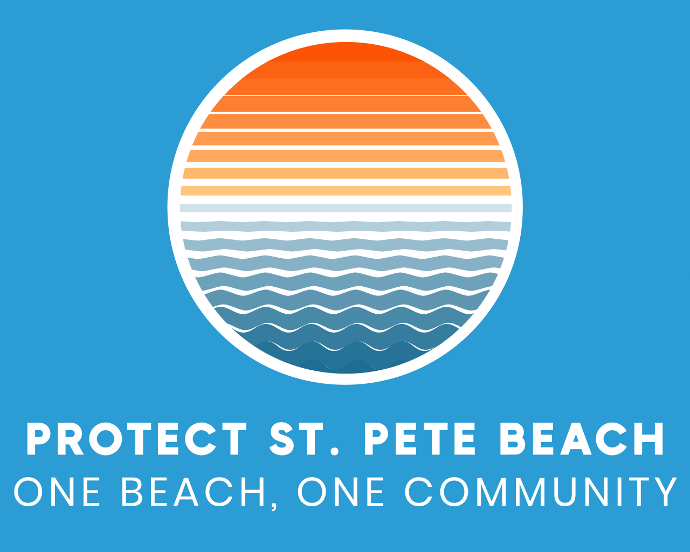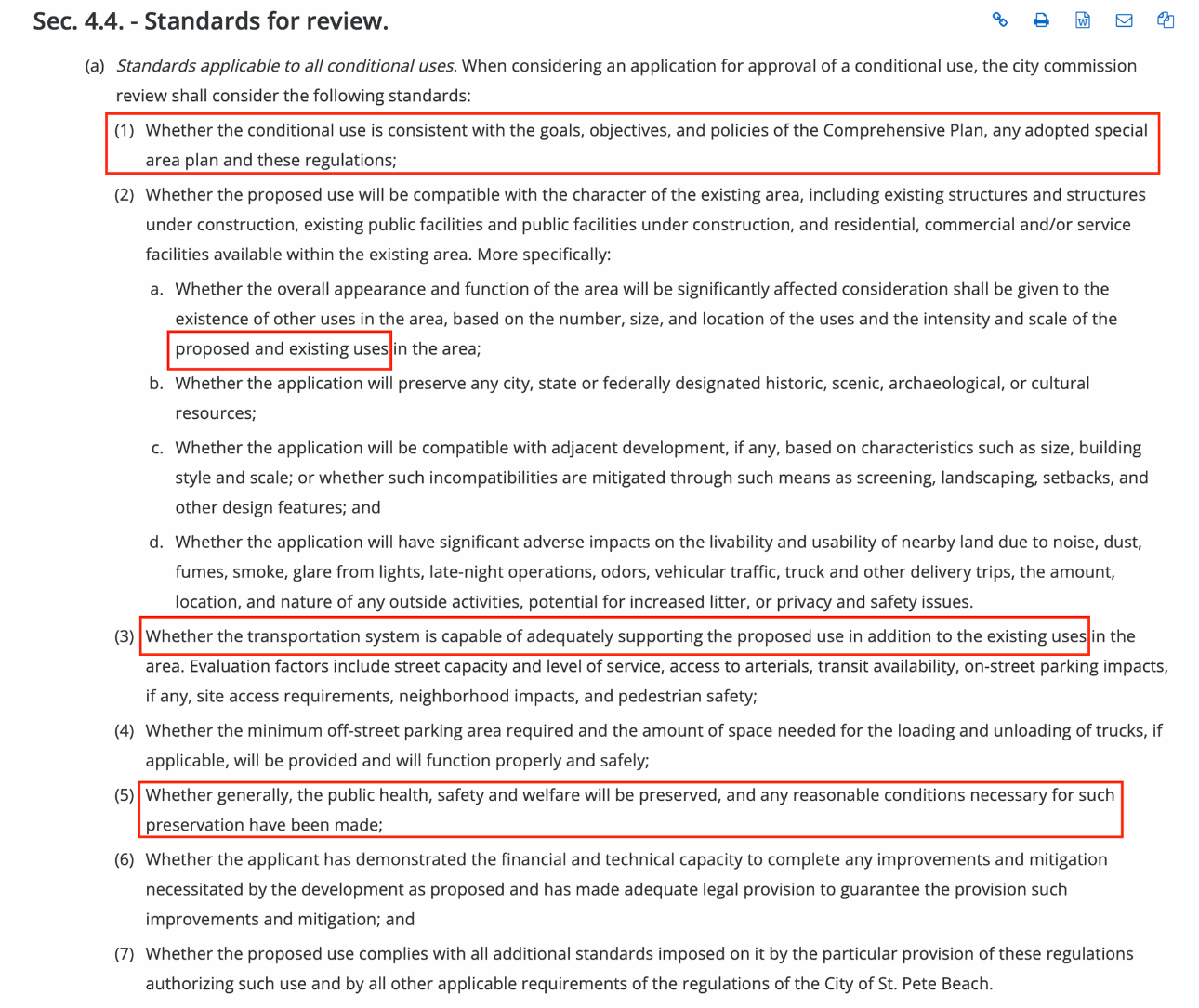Petition Against Approving Sirata and TradeWinds Conditional Use Permits as Proposed (Results Submitted as Evidence Supporting our Opposition of Approval)

Two of our largest resorts, Sirata and TradeWinds, desire to expand their properties beyond the by-right allowable limits of our Land Development Code:
- Sirata has submitted a Conditional Use Permit application requesting permission to increase rooms by 69%, from 382 to 646 rooms (75 units per acre), with 747 parking spaces, and increasing height to 116 feet.
- TradeWinds has submitted a Conditional Use Permit application requesting permission to increase rooms by 65%, from 967 to 1,596 rooms (69 units per acre), with 2,113 parking spaces, also increasing height to 116 feet.
St. Pete Beach’s Land Development Code allows 30 units per acre and 50 feet in height. Requesting permission to increase beyond those limits is not an entitlement, but rather a request to be considered. Indeed, it is the size of these expansions that requires approval through the conditional use permit process.
Our city has never before faced proposed expansion plans of this size, scale, and density. These requests are unprecedented, and represent over half the acreage of our Large Resort district. If approved, they set a powerful precedent that will inevitably transform St. Pete Beach into Clearwater Beach with increased traffic, crowding, and a mile-long wall of tall buildings blocking views and ocean breezes -- among other impacts.
Finally, case law establishes that lay testimony concerning the character of our community and the impact of proposed development on that character can be competent and substantial evidence in quasi-judicial proceedings.
Therefore, as a St. Pete Beach resident, I petition the City Commission of St. Pete Beach to:
1) Recognize that these two conditional use permit applications request development inconsistent with comprehensive planning goals and objectives, increase the burden to our transportation system beyond its capacity, and threaten health and safety as detailed below, therefore failing to meet the Standards for Review as stated in the land development code, all while failing to actually rebuild the old, out-of-code buildings that will remain in the Community Redevelopment District as such.
2) Should application #23053 for the Sirata come to a vote, please vote to deny or defer a decision pending submittal of an improved site plan. Should application #23033 for TradeWinds come to a vote, please vote to deny or defer a decision pending submittal of an improved site plan.
3) Request that the developers meet with community members and organizations to develop plans that move our Community Development District forward towards its enumerated goals in the Comprehensive Plan prior to submitting any revised proposals.
Rationale
Our Land Development Code identifies seven Standards for Review that must be met by the applicant in order to grant approval:

Standard 1
The first and simplest standard for review is, “Whether the conditional use is consistent with the goals, objectives, and policies of the Comprehensive Plan, any adopted special area plan, and these regulations.”
Both of these developments are in the defined “special area plan” called the Community Redevelopment District. Goal 1 and Goal 3 for the Community Redevelopment District are as follows:
- Goal 1: To support achieving a quality sustainable community through livable community design standards as well as Green building, site design and operation strategies.
- Goal 3: To rebuild the core commercial and resort areas of the City utilizing Green practices, strategies and technologies.
Both of these proposals are asking permission to add hundreds of new rooms and parking spaces alongside aging facilities that do not, and cannot, satisfy the Objectives and Policies of these two Goals.
In other words, Sirata and TradeWinds adding new rooms “built to the latest Green building, site design, and operation strategies” cannot compensate for the fact that the original facilities remain, with construction and infrastructure that do not meet modern standards for efficiency, storm resilience, environmental sustainability, and essential features like sea turtle-friendly glass that are required in new construction.
Adding new construction alongside aging facilities is not "rebuilding". Because these proposals do not satisfy Goals 1 and 3, they should not be granted permission for additional density. The asset of new construction does not, and cannot, offset the liability of aging obsolete buildings.
Standard 2
The second standard for review requires that the proposal is "compatible", and specifically if the overall "appearance and function" of the area will be significantly affected considering "intensity and scale of the proposed and existing uses" in the area. In other words, the Land Development Code says that we must consider these two applications in the context of one another, because we must consider the intensity and scale of both proposed and existing uses -- and they are being proposed at the same time.
The Sirata proposal and a proposed CUP for Tradewinds Islands Resort which you will consider subsequently constitute about half the acreage in the Large Resort Future Land Use District. These are highly significant redevelopment proposals which will lock in the pattern for redevelopment for the Gulf Boulevard Large Resort District.
As such St. Pete Beach should consider the cumulative impacts of a development scenario where all of the Large Resort District maximizes transient unit density as is being requested by Sirata. Should all of the 65-acres of Large Resort redevelop at 75 units per acre it would result in about 4,875 hotel units in that area alone. For context St. Pete Beach currently includes 54 hotels with 3,087 rooms.
An analysis of cumulative impacts should be comprehensive with particular attention to peak season traffic congestion, pedestrian safety, beach overcrowding and sea turtle protection, and adverse effects on community character and quality of life. A cumulative analysis would put the city in a position of manage redevelopment to an appropriate level which does not degrade infrastructure and public services to a degree detrimental to the public and character of the community.
Clearly, an increase in rooms, cars, and people of this magnitude, covering over half of the Large Resort District's area, will significantly affect the appearance and function of the area, to our city's future detriment.
Standard 3
The third standard for review requires that the existing transportation system is "capable of adequately supporting the proposed use in addition to existing uses". At the present, however, neither proposal includes a comprehensive transportation impact analysis that considers both proposed expansions and adequately takes into account congestion on Gulf Boulevard that occurs during peak season conditions.
Instead, the proposals simply state that the existing roadway network and nearby intersections are sufficient. Because the applicants have not performed sufficient analysis to consider peak season congestion throughout the island in the context of both proposed expansions, these proposals do not satisfy Standard 3.
Standard 5
The fifth standard for review requires that the public health, safety, and welfare will be preserved. These two applications are adding an additional 900 rooms and suites. With guests and staff, this expansion implies at least an additional 2,500 people on the island, with more for special events. To maintain service levels at current population and tourism levels, St. Pete Beach just added four additional Fire/EMS personnel and two law enforcement personnel. Note that St. Pete Beach Fire/EMS calls have risen from ~3,000 to 4,000 since 2016 with an increase in visitors, yet these most recent staffing additions are the first since 2016.
Additional resort guests create additional demands on law enforcement, as well.
Because our current Fire/EMS and law enforcement personnel are operating at capacity, additional guests and staff from proposed expansions will endanger health and safety, thus violating Standard 5.
Citizen Input
Our Comprehensive Plan requires resident input be considered during the review process. As a resident of St Pete Beach, I support redevelopment that adheres to our Land Development Code, and respects the principles outlined in our Comprehensive Plan Section I: Citizen Input on Community Redevelopment.
Specifically, over one thousand St. Pete Beach residents have signed the “We Can’t Survive 75” petition, proving that St. Pete Beach residents continue to:
- Strongly object to high density overdevelopment of our coastal Gulf community that will further degrade infrastructure, public services, environment, wildlife, and safety; and
- Strongly protect the quiet character of existing residential neighborhoods from the encroachment and overdevelopment of non-residential units.
Evaluation of the impacts on community character should heavily weigh input from your residents. It is your residents, after all, that are the mainstay of your community who know the character of the community the best. It is your residents whose health, safety and welfare you are to protect.
The Plan references concerns about high density redevelopment and protection of community character as identified in the attached analysis. In particular:
- Future Land Use Goal 2 requires that the City’s residential character be maintained and protected;
- Future Land Use Objective 2.1 is to maintain the integrity and quality of life throughout the city including existing neighborhoods; and,
- Future Land Use Objective 2.4 requires that the city’s character be enhanced and protected.
Read the Detailed Technical Review
For a detailed technical review of the Sirata and TradeWinds CUP Applications, please reference the following article:
Charles Gauthier, FAICP, Publishes Analysis of Sirata CUP Application
Mr. Gauthier's technical review at the link above was submitted for the Sirata Planning Board meeting, and we strongly support his final recommendation:
Recommendation
Carefully evaluate both the immediate physical impacts of the proposed Sirata CUP and the broader impacts on the character of St. Pete Beach as a whole.
Should you agree that important issues are not adequately addressed, the Planning Board should recommend to the City Commission that the CUP be sent back to city staff and the applicant for further examination, with opportunities for public consensus building, and appropriate revision. It seems to me that a win-win situation is available.